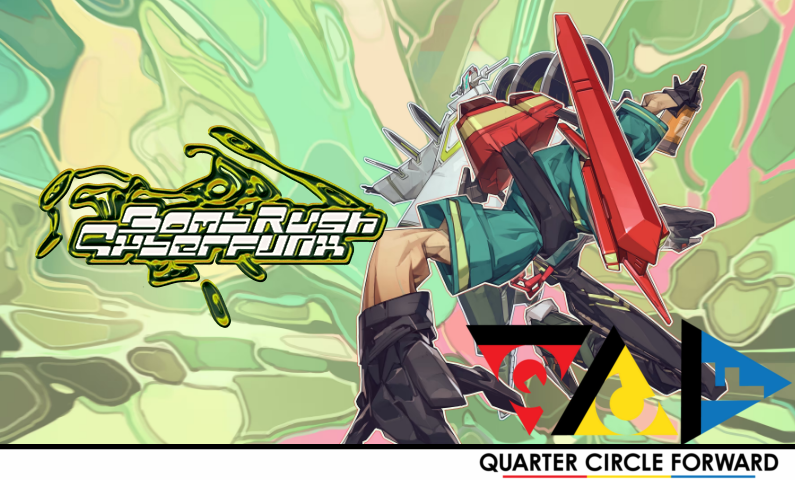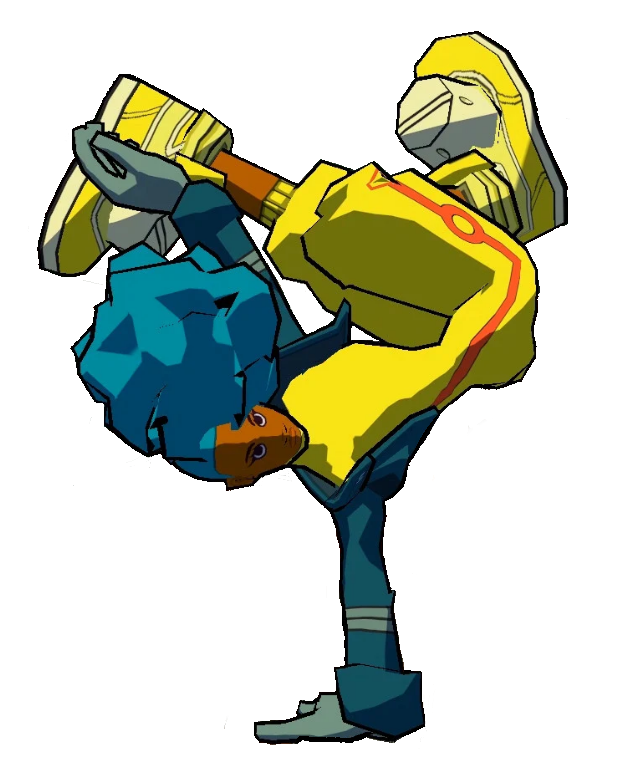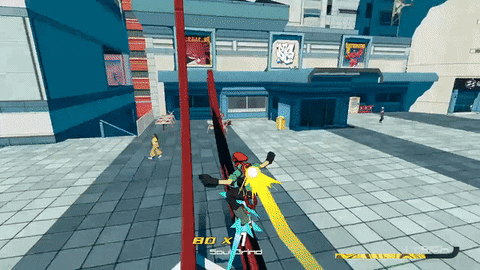QCF: Bomb Rush Cyberfunk

 find it pretty funny that I’m writing this review mere weeks after the Dreamcast’s 24th Anniversary; I mean, not just that in that granular humor from a well-timed coincidence sort of way, but in that I’m still seeing one of my favorite consoles live on through a legacy that dwarfs its flash-in-the-pan lifespan. Even though it was released two years into the 128-Bit Machine’s reign, Jet Grind Radio left quite the impact in 2000, as it quickly became a must-have exclusive for the platform and yet another reason to attract anyone over to SEGA hardware instead of Nintendo’s or Sony’s offering.
find it pretty funny that I’m writing this review mere weeks after the Dreamcast’s 24th Anniversary; I mean, not just that in that granular humor from a well-timed coincidence sort of way, but in that I’m still seeing one of my favorite consoles live on through a legacy that dwarfs its flash-in-the-pan lifespan. Even though it was released two years into the 128-Bit Machine’s reign, Jet Grind Radio left quite the impact in 2000, as it quickly became a must-have exclusive for the platform and yet another reason to attract anyone over to SEGA hardware instead of Nintendo’s or Sony’s offering.
After an underwhelming sequel and years of Fan-service cameos, SEGA’s frenetic Graffiti-racer has mostly lived on as a garnish for the repeated servings of nostalgia surrounding the Japanese brands’ peak years. Given that the property has undoubtedly had more of an impact than SEGA had accounted for, it was only inevitable that one studio would set out to tag the spot Jet Grind Radio had left untouched for twenty years.
Netherlands studio, Team Reptile, answered the call, & endeavored to produce a spiritual successor to the Dreamcast Cult favorite with Bomb Rush Cyber Funk, an improved open-world take over the middling attempt we saw out of Jet Set Radio Future, with a freestyle approach to progression. The end result isn’t just a fresh approach to a familiar classic but a practical reinvention that improves upon its source material in nearly every single way.

Let’s get this out of the way right now—it’s going to be impossible to discuss what makes Bomb Rush so good without bringing up the cult classic that inspired it. Even so, that doesn’t mean that Team Reptile’s Love Letter can’t deliver in its own right, and the best argument for that case is the way it sets its world apart with a level of gravitas that engages players right out the gate. Where Jet Grind heavily leaned into the Acid-washed Techno Punk Culture that consumed Tokyo in the late Ninties, Bomb Rush takes that vibe and expands on it with a heavier emphasis on dystopian elements, punching down on themes like Police State Tyranny and Technological Singularity. The world-building of New Amsterdam doesn’t waste any time in establishing these themes, quickly seating you into the role of Faux, an up-and-coming rebel who, in the span of one hour, gets arrested by the cops, joins a gang, escapes the fuzz, and then gets killed.
 Thankfully, after some Sci-Fi Body Horror coming to the rescue, Faux is reborn as a Metal-Headed Delinquent nicknamed Red, complete with amnesia on the brain and vengeance behind his eyes. The Rebel with a Cause approach is a refreshing change of pace from the typical displays of millennial angst, as Bomb Rush endeavors to offer a more meaningful look at the “fight against the machine” angle. There are poignant moments where topics like freedom, identity, and self-expression actually manage to land some insightful commentary on its subject matter instead of the lazy-ass satire we’ve been accustomed to from this sort of trope over the years.
Thankfully, after some Sci-Fi Body Horror coming to the rescue, Faux is reborn as a Metal-Headed Delinquent nicknamed Red, complete with amnesia on the brain and vengeance behind his eyes. The Rebel with a Cause approach is a refreshing change of pace from the typical displays of millennial angst, as Bomb Rush endeavors to offer a more meaningful look at the “fight against the machine” angle. There are poignant moments where topics like freedom, identity, and self-expression actually manage to land some insightful commentary on its subject matter instead of the lazy-ass satire we’ve been accustomed to from this sort of trope over the years.
As relieving as the narrative build was, I was really looking to feast on the graphics and sound, as the Jet Grind property is iconic for being the sweet candy it is for the media-hungry senses. This decades-old game delivered unique graphics and music that aged like century-old cabernet among its sixth-generation peers—how could Bomb Rush Cyberfunk live up to such expectations?
Phenomenally, that’s how.
Cel-shading has come a long way since the halcyon days of the early 2000’s, and the rendering of the style in Bomb Rush is an incredible testament to that growth. The sharp, thick-drawn lines for every character model and rig are immaculately animated with bright, radiant color schemes that really bring out the neon highlights of the game’s Techno Punk aesthetic, all animating at 60 frames per second without a hitch in performance. Like, I can’t express how impressive these visuals are at the consistency of the framerate without any kind of screen tear, slowdown, or graphical artifacts like shimmering or banding—everything works as it should and is optimized to such an impressive degree considering the dynamic animation of the Cel-Shaded graphic style. I also want to add that this is based solely on the Nintendo Switch version, a platform infamous for graphical/performance concessions in contrast to its contemporaries.

While not all soundtracks can be blessed with having Guitar Vader’s “Super Brothers” or Rob Zombie’s “Dragula” on their set, the audible licks for Bomb Rush Cyberfunk’s track list is no slouch with a slew of memorable tracks that genuinely resonate with the haptic atmosphere of the title. There are plenty of evocative songs that come to mind like “Precious Thing,” “GET ENUF,” or the eternally catchy “watchyaback!” sounding off to the action on screen with all of the right punch and beat behind them. Something that really struck out to me is the sheer sundry of artists that Team Reptile worked with for the composition, with each one seemingly scouted from their respective underground, with track list that’s almost seemingly made up of independent artists—it’s warmly comforting to see that old adage of “A Rising Tide Raises All Ships” at work here.

Regardless of whether or not the presentation would come off phenomenal or uninspired, musing the familiar sights and sounds of the Dreamcast Gem is arguably the easiest hurdle to doing a modern-day Jet Grind Radio justice—the real challenge is delivering a gameplay that feels just as good, if not better than what we’ve seen from SEGA. While some flourishes aren’t as elegant post-concept, Team Reptile has masterfully evolved the core foundation of frenetic urban conquest into an Open-World free-for-all that’s hard to put down.
To start, one of the most natural yet significant additions to the gameplay loop is the heavier emphasis on Tricks, where players will find themselves chaining multiple maneuvers in a string of combos for large of their level objectives, the lines of almost Tony Hawk Pro Skater-like setup. The comparison isn’t being made lightly either, as players are able to execute similar button inputs to perform flip or grab tricks in mid-air, and even Manual/Skitch on the pavement in between the aerial moves to keep the chain going for as long as the combo meter lasts. Bomb Rush doesn’t demand as much perfection as the birdman games do, with the  Combo meter being flexible enough to pause whenever you launch into the air, resuming where the meter last left off so long as another gliding trick is performed to maintain the current trick streak, and even refreshing the meter altogether when chained into a grind. Successful chaining is more about momentum and stage awareness than more advanced nuances like physical balancing or trick form. Executing tricks on the fly is the only update, as jumping from rail to rail is even easier with a new double-jump jet boost that can give you that crucial sir time needed to cover vast gaps between grinds or platforms and possibly stretch your trick chains into the triple digits if you wanted to.
Combo meter being flexible enough to pause whenever you launch into the air, resuming where the meter last left off so long as another gliding trick is performed to maintain the current trick streak, and even refreshing the meter altogether when chained into a grind. Successful chaining is more about momentum and stage awareness than more advanced nuances like physical balancing or trick form. Executing tricks on the fly is the only update, as jumping from rail to rail is even easier with a new double-jump jet boost that can give you that crucial sir time needed to cover vast gaps between grinds or platforms and possibly stretch your trick chains into the triple digits if you wanted to.
This new trick system significantly enhances the already addictive agency that the Jet Grind-inspired physics offered, as maintaining solid momentum is more within the player’s control instead of being utterly dependent on contextually sensitive “trick” routes within the level. Speaking of the levels, while Bomb Rush takes more after the the level design of the underwhelming Xbox sequel, with inter-connected sections of New Amsterdam—only here, the execution has been refined into a world that feels less like a HUB with stages and more like an actual metropolis that’s densely woven together dozens of vibrant districts to explore.
What makes the world feel so much more prominent in scale is how diverse the city architecture is in its design, establishing each locale with its own sense of identity that is both fun, and intuitive to navigate. In addition to the usual cues we’ve seen from Shibuya or Times Square, locales will expand with intricate San Francisco-like alleys, Jersey Turnpike tunnels, expansive Bay City canals, and even labyrinthine buildings like Malls or City Centers that are all built around the frenetic mechanics of player movement. Unlike the opaque urban mazes that Jet Set Radio Future levels are infamous for, however, Team Reptile took what worked from  those blueprints and constructed something that manages to deliver an immense sense of scale without ever compromising the ease of traversal with areas that are free of bland city blocks or nonsensical cul-de-sacs to stunt your progress. I can’t tell you how little I had to reference the map when I was shredding through the streets of New Amsterdam—every spot felt so seamless to skate to, like I was rolling through my very hometown. The intuitive sense of navigation lent so much to the nonlinear model of Bomb Rush Cyberfunk—unlike the rigid stage-to-stage gameplay of the property it muses, Red and company are tasked with building a rep score advance towards the status of “All City.” Rep can be earned by either tagging art in whatever order you’d like, or challenging the flunkies of the regional gang to a game of Horse, where beating them will net you a fair boost of rep as well. The more Rep you earn, the closer you get to earn the right to face off with the group that’s staked claim over the area. Coloring the town won’t just get the attention of the local hood, though, as New Amsterdam has spent a fortune of their city budget towards a small army that’s hell-bent on taking anyone on wheels out.
those blueprints and constructed something that manages to deliver an immense sense of scale without ever compromising the ease of traversal with areas that are free of bland city blocks or nonsensical cul-de-sacs to stunt your progress. I can’t tell you how little I had to reference the map when I was shredding through the streets of New Amsterdam—every spot felt so seamless to skate to, like I was rolling through my very hometown. The intuitive sense of navigation lent so much to the nonlinear model of Bomb Rush Cyberfunk—unlike the rigid stage-to-stage gameplay of the property it muses, Red and company are tasked with building a rep score advance towards the status of “All City.” Rep can be earned by either tagging art in whatever order you’d like, or challenging the flunkies of the regional gang to a game of Horse, where beating them will net you a fair boost of rep as well. The more Rep you earn, the closer you get to earn the right to face off with the group that’s staked claim over the area. Coloring the town won’t just get the attention of the local hood, though, as New Amsterdam has spent a fortune of their city budget towards a small army that’s hell-bent on taking anyone on wheels out.
The faster you build your rep, the quicker your heat meter will rise, determining how often you’ll run into the bastards in blue, pitting you in situations where you’ll have to run from a squad of Badges, and lay low until the heat dies down. Well, I couldn’t be happier with how Bomb Rush approaches this dynamic, as players can now trade their wheels in for fists and actually get to fight back for a change!
That’s right—to rule the streets of New Amsterdam, you’ll use more than some well-time spray paint to throw down; you have bonafide attacks to strike back at your enemies for a change!
Red and the rest of the Bomb Rush crew have a punch and kick attack in their arsenal that they can string for different combos to knock back oncoming coppers, making it easier to create some distance when you need to get back to tagging or tricking at hand. Sometimes running away won’t be an option, and players will be forced to contend with boss fights with the higher ranking officers who’re really eager to shit on your day. The boss fights with the jerks in uniform are far more satisfying in this incarnation because whether they’re wielding rocket launchers, jetpacks, or sniper rifles, you’re encouraged to fight back and create an opening to spray them senseless instead of just waiting for an opportunity to arrive through a tedious standoff with rinse-n-repeat tactics.

Skirmishes with rival gangs are far more familiar as they’ll involve the typical match of Horse, race, or even a “Pro Skater” Score Attack match that’s judged from a respected Street Gang. These moments are steadily ramped up with every new territory challenge, and the opposing writer you face off against gets gradually more ridiculous in both theme and skill. I always found myself torn between rushing off to see who the next wacky gang I’d face off against or if I should keep boosting my rep because exploring the levels was just that fun.

Honestly, the only knock I have against this otherwise incredible take on the Jet Grind foundation is the graffiti tagging mechanic—while lightyears better than the lame single-input spray mechanic we were stiffed with in Jet Set Radio Future, the fluid quarter-circle almost cursive-like command inputs of the Dreamcast original aren’t here either. What we’re given instead is a Pentagon-shaped web to weave intersection lines between the five points ala “Cat’s-Cradle” style, where the starting points and subsequent connections made will yield various graffiti designs that differ between different combinations of connection points. The system does admittedly take some time to get used to. Still, it’s just not as instinctive as the previous system, especially when the commands harmonized to the same sort of synchrony the game commands for every other input of movement. This system just feels less, artful, if that makes any sense.
Minor quibbles aside, the sheer magnitude of detail that went into developing this title centered on a legacy as lofty as Jet Grind Radio is nothing short of incredible. To say that Bomb Rush Cyberfunk is a spiritual successor to the SEGA franchise is a discredit to both the game, & the core ethos of the term. This title is outright THE successor to the Jet Set Radio Heritage, and SEGA would be wise to network to the studio now with the high they’re riding. Bomb Rush Cyberfunk is THAT good, like, Game-of-the-Year material, so please don’t hesitate to download this game gem as soon as yesterday.






 Press Pause Radio
Press Pause Radio 





Reader Comments